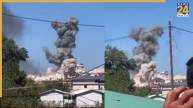Idlib: The US military has announced that a drone strike conducted in eastern Syria resulted in the killing of an ISIS leader. According to a statement released by the US Central Command (CENTCOM) on Sunday, Osama al-Muhajer was targeted and eliminated in the strike that took place on Friday.
Meanwhile, the CENTCOM chief, Michael Kurilla, emphasized the commitment to defeating ISIS in the region, stating, “We have made it clear that we remained committed to the defeat of ISIS through the region.”
He further emphasized that ISIS continues to pose a threat not only to the region but also beyond.
CENTCOM also asserted that the drone strike did not result in any civilian casualties, although reports of a civilian injury are being assessed by coalition forces. Notably, the drones involved in the operation had encountered harassment from Russian warplanes earlier on the same day, as reported by Al Jazeera.
The incident follows a series of encounters between US and Russian military aircraft in Syria. On Thursday, Russian planes allegedly interfered with US drones engaged in operations against ISIS.
Lieutenant General Alexus Grynkewich of the US Air Force reported that Russian jets dropped parachute flares in front of the drones and flew dangerously close, compromising the safety of all aircraft involved. He urged Moscow to cease such reckless behavior.
This is not the first time Russian interference with US drones has been reported. Earlier this year, the US accused Russian jets of causing the downing of a Reaper drone over the Black Sea. While Moscow denied responsibility, US military video footage allegedly showed Russian planes obstructing the drone’s flight path.
The ongoing Syrian crisis has witnessed Russia’s crucial support for President Bashar al-Assad’s administration. With Russian and Iranian assistance, Assad’s regime has regained significant territory lost during the early stages of the conflict. However, armed opposition groups still control the Idlib region in northern Syria.
As part of global efforts to combat ISIS, the United States maintains around 1,000 troops stationed in Syria. Despite the group’s significant territorial losses in 2019, it continues to maintain hideouts in remote desert areas and periodically carries out attacks.
The situation highlights the complex dynamics involving various actors, including the US, Russia, and local factions, as they navigate the challenges posed by extremist groups and the broader Syrian crisis.













